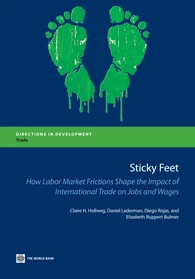
Just consider: If your wage was suddenly cut, would you remain in your current job despite the loss in earnings? Would you quit immediately, or look for a new job while continuing to work? How long could you survive on your lower earnings? Would you be forced to sell your house or other assets? How much money and effort would you invest in finding a better job? Would your personal circumstances allow you to take a better job in a distant location? Would you uproot your family for this job?
Because workers are human, their labor supply decisions are affected by a collection of factors, not all of which are easy to quantify.
Workers’ lives are complicated, and these complications tend to cause workers to avoid or delay changing jobs. In economic terms, we say that worker mobility is costly.
In the face of significant mobility costs, workers exhibit “sticky feet.” When we consider the aggregate effect across all workers in an economy, these collective sticky feet translate into sluggish and potentially suboptimal labor reallocation, which has an economic cost.
This raises two fundamental questions: How do workers react to changes in wages when there are frictions that impede job switching, and how does this affect the ultimate allocation of workers across sectors?
To answer these questions, the World Bank Group undertook extensive analysis of trade-related price shocks in a sample of 47 developed and developing countries to measure labor mobility and labor adjustment costs.
Our objective was to better understand how a trade-related price shock can affect worker welfare, as reflected by post-shock employment and wage outcomes. The results of our analysis were recently published in a new book, Sticky Feet: How Labor Market Frictions Shape the Impact of International Trade on Jobs and Wages.
Measuring two types of costs
Labor mobility costs are the costs perceived by a worker of moving to a different firm or industry, regardless of the reason for the move.
When, however, workers are unable to move in response to an exogenous shock, such as a change in trade policy or in the international market, the total costs incurred by workers (and the economy) are defined as labor adjustment costs. For a trade-related shock, adjustment costs due to sluggish reallocation of labor can be interpreted as foregone gains from trade.
Our new analysis develops methodologies for indirectly measuring labor mobility costs at the sector level and for different types of workers, and devises a simulation strategy to estimate the magnitude of labor adjustment following a trade-related price shock, the length of time required to transition to a new steady state, and the welfare effect on workers.
These methodologies comprise a new trade and labor adjustment costs toolkit, as explained in Sticky Feet. For countries where panel data is available on workers’ job transitions over time, the toolkit can be used to estimate mobility costs disaggregated at the sector level, as well as for different worker characteristics (e.g. skilled vs. unskilled, formal vs. informal, male vs. female).
In countries lacking panel data but for which we can estimate average labor mobility costs – namely the 47 countries in our database – we can simulate the adjustment paths of wages and employment at a more aggregated level.
For policymakers considering trade policy changes or responses to external permanent shocks, it is important to understand the relative magnitude of potential labor mobility and adjustment costs.
What do we find?
Workers face very high mobility costs, especially workers in developing countries. The average cost faced by workers to switch jobs is 4.93 times the annual average wage in developing countries, compared to 2.41 times the annual average wage in developed countries. Countries with a large employment share in primary sectors such as agriculture tend to have higher mobility costs, as do countries with low levels of tertiary education. The evidence also shows that labor mobility costs are positively correlated with other frictions and constraints such as the number of days required to export. These results suggest that workers in developing countries will be more vulnerable to the effects of a trade shock because of the higher cost of switching jobs compared to workers in developed countries.
Mobility costs vary by sector and by worker type. There is significant heterogeneity in the mobility costs for workers entering different industries, costs that may be related to the amount of skills needed in specific industries. But even within the same industry, mobility costs vary by workers’ skill level. Entry costs into formal employment are significantly higher than for informal employment. The fact that informal jobs are easier to access is critical to understanding how the poor are affected by trade shocks, as informal employment can act as a stepping stone to formality. These findings could help policymakers identify industries that are more difficult for workers to access, pointing to potential underlying factors, and highlighting the importance of considering labor mobility costs at the industry rather than the aggregate level.
It is workers – rather than firms – who bear the brunt of adjustment costs. When a trade shock hits a developing country, the costs associated with workers’ decisions are notably higher than those associated with employers’ decisions. A firm’s adjustment cost resulting from trade liberalization might be lost profits because of an overextended payroll or a short-term inability to sell unneeded capital assets, for example. But evidence suggests that the costs incurred by workers – including lost and/or reduced wages or spells of unemployment – far outweigh firms’ costs.
The presence of labor market frictions reduces the potential gains from trade reform. For instance, when tariffs are reduced in one sector, the resulting change in relative prices raises real wages in some sectors and reduces real wages in the liberalized sector. The wage gaps that emerge cause workers to reallocate their labor. But because workers incur costs to change jobs, the magnitude of these mobility costs affects workers’ decision about seeking alternative employment in a new firm, sector, or region. The higher the mobility costs, the slower the transition to the new steady state in the labor market. Workers’ sticky feet result in foregone welfare gains from trade in terms of employment and earnings.
Labor adjustment costs can be very large. Lost earnings are the main preoccupation of trade reform. While it is generally understood that in the long run, liberalizing trade will lead to higher wages and employment, in the short run workers in some sectors may suffer. This leads to the fundamental question about worker welfare: How long will it take for a displaced worker to return to his/her previous wage level? The simulated adjustment paths of sectoral wages and employment following a tariff cut that translates into a 30 percent decline in domestic food and beverage prices indicate a recovery period ranging by country from two to 15 years.
Implications of the results
Our analysis and the associated toolkit can help policymakers better anticipate the potential labor market impact of a prospective policy reform in a sector, and help identify which alternative sectors displaced workers are likely to enter.
If trade liberalization is likely to lead to plant closures, policymakers should be aware that wage recovery for laid-off workers is relatively slow. Traditional social safety nets that provide temporary relief might not be sufficient given that trade shocks can have more permanent sector-wide effects.
Because workers bear the brunt of labor adjustment costs, it is important that policy solutions be aimed primarily at reducing labor mobility costs rather than firm-side labor adjustment costs. Policy design should therefore focus on minimizing worker mobility costs and accelerating their employment transitions. Governments might consider putting in place programs that alleviate labor adjustment costs but do not prevent the economy-wide restructuring that accompanies trade liberalization.
For more information, contact Elizabeth Ruppert Bulmer at eruppertbulmer@worldbank.org.




Join the Conversation